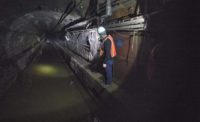Nuclear Regulatory Commission engineers and Duke Energy Carolinas representatives met on March 25 to discuss the utility's plan to protect the Oconee nuclear station's standby shutdown facility, or SSF, in the unlikely event the Jocassee Dam, located upstream of the station, were to fail catastrophically.
In the wake of the Fukushima nuclear accident in March 2011, the NRC has been expanding its review of U.S. nuclear units' ability to withstand natural phenomena, including flooding, said commission spokesman Scott Burnell.
Addressing the engineers at the NRC's Rockville, Md., headquarters last week, Duke proposed modifications to protect against the possibility of dam failure, including relocation of an external backup transmission line, intake-dike embankment protection, east embankment protection and construction of a discharge diversion wall.
In a slide presentation, Duke also listed three proposed modifications to protect against the possibility of locally intense precipitation, including "transformer relocation; diversion walls and drainage canals; [and] auxiliary building and turbine building protection."
After the meeting, Duke spokeswoman B.J. Gatten said the relocation of the external backup transmission line is "in the process of being completed." The other modifications are under NRC review and would require additional design work if they were to be accepted, she added.
Prompted by a Freedom of Information Act request, the NRC's March 12 release of more than 90 documents related to fears about potential flooding at the three-unit Oconee station near Seneca, S.C., revealed decades of on-and-off concern regarding the potential threat of a Jocassee Dam failure.
The documents show that, in 1977, the NRC had expressed concern about the potential of dam-failure-related flooding at Oconee and that a 1992 flood inundation study conducted by Duke indicated floodwaters could swamp the five-foot walls protecting the station's SSF.
An NRC inspection report in 1994 indicated that Duke promised to address the issue, but the matter was dropped. The following year, Duke said the threat of dam failure was lower than it previously believed and that the SSF's five-foot walls were sufficient.
In 2006, however, an NRC inspection of Oconee concluded the risk of catastrophic dam failure was higher than Duke figured, "and that the licensee's estimate was not adequately supported by operating experience and actual performance data of similar rock-filled dam structures," according to documents.
In 2007, the NRC said flood modifications may be needed and told Duke to provide additional information. In 2008, NRC's research team said that it had not been aware of Duke's 1992 inundation study or the NRC's 1994 inspection report.
Tom Clements, southeastern nuclear campaign coordinator at Friends of the Earth, said that while the probability of a Jocassee Dam failure is low, it is "a high-risk event that would flood the Oconee site, resulting in serious impacts, so it is urgent that the site immediately comply with relevant regulation or shut down until it does."





